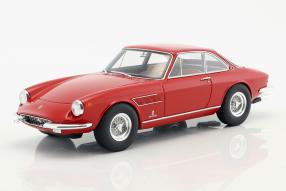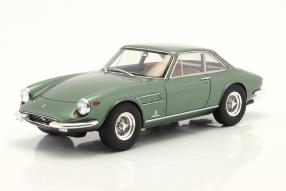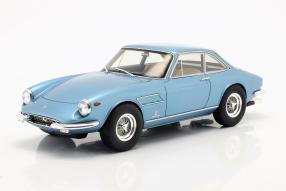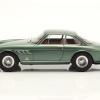In today's blog, we are presenting a street sports car by Ferrari from the 60s in the colors red, blue and green metallic. The model was produced exxlusively for ck-modelcars by modelcar manufacturer CMR. The label did a great job with replicating the classic from the house of Ferrari true to detail. As we already know from CMR, a great deal of attention to detail was paid to the work. From the fine-spoked rims, the chrome applications to the 4-pipe exhaust system, some details correspond absolutely to the original model. The Ferrari 330 GTC speaks a design language reminiscent of designers like Zagato or Pininfarina. With the colors red, metallic green and blue, CMR has created a selection that every collector of timeless classics should get their money's worth. Luckily the price of the 1:18 model remains affordable as an original 330 GTC is currently selling for between 1.5M and 2M depending on the condition it is in.
It was in the early 1960s when Ferrari laid the foundation for the 330. At that time, the car manufacturer from Maranello divided its product range of road sports cars into several segments. The 275 GTB was the sporty two-seater, while the 250 GTE 2+2 and 330 GT2+2 covered the four-seater Gran Turismo segment. The two-seater 250 GT Lusso sat right between these two products in the range. The production of the Lusso ended in 1964 and the gap was not closed again until with the 330 GTC two years later. Visually, the responsible designer was Aldo Brovarone, but this approach was based on Pininfarina designs. Several Ferrari models were combined in the 330 GTC. The front end was based on the exclusive 500 Superfast. The rear end bears a resemblance to the 275 GTS. While the hoods and doors were made of aluminum, the rest of the body was mostly made of steel.
The centerpiece of the 330 GTC is its twelve-cylinder, to which it also owes its name. The volume of every cylinder at the engine of the 330 GTC namley is 330 ccm. The original concept of the engine already came from the year 1947 and was newly worked up for the 330 GTC. The engine then delivered around 300 hp with a total displacement of 3967 ccm and brought the 330 GTC to a top speed of 242 kph. At the end of the 1960s, there was no need to worry too much about fuel consumption. The 330 GTC had a tank with a capacity of 90 liters. In order to monitor engine performance, the driver had a number of displays in the cabin. In addition to the rev counter and the speedometer, a triple combination of cooling water temperature, oil temperature and oil pressure was displayed. Fuel level, ammeter and time could be read in the center of the dashboard. The model, which remained almost unchanged during its two-year production period, ended up with 598 coupes and 100 Spyders that were built.
Gallery














 [02.03.2022] IronForce Collection by Ixo: many colors, many models
[02.03.2022] IronForce Collection by Ixo: many colors, many models [02.03.2022] IronForce Collection by Ixo: many colors, many models
[02.03.2022] IronForce Collection by Ixo: many colors, many models

